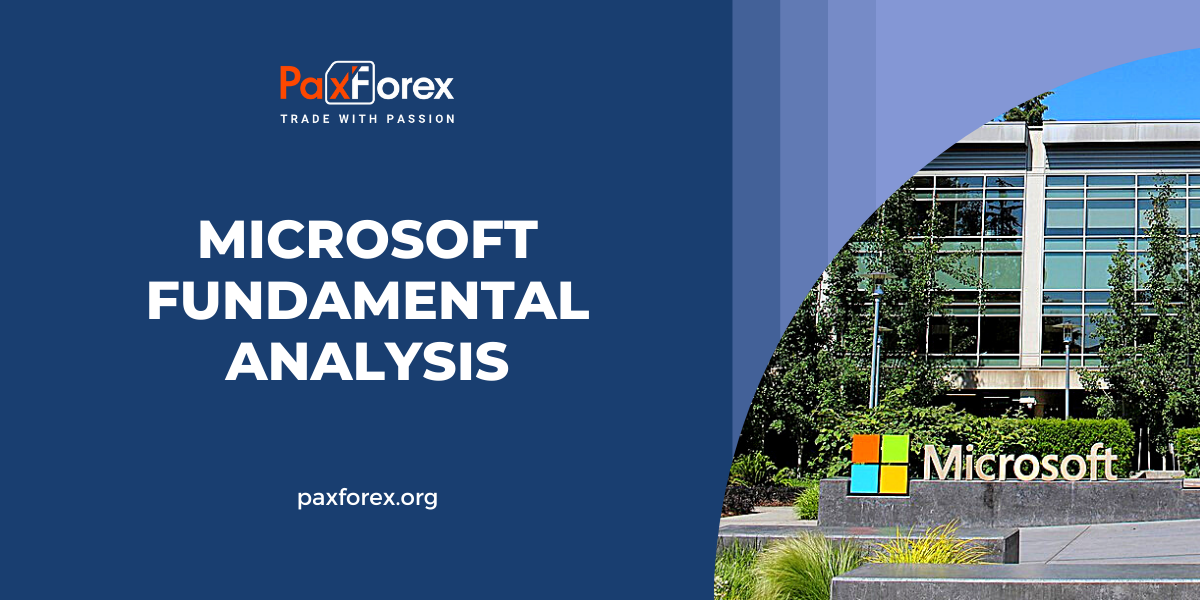
Source: PaxForex Premium Analytics Portal, Fundamental Insight
Microsoft has experienced a remarkable surge over the past year, propelled by a broader market rebound and a substantial recovery in the technology sector. The productivity software and cloud computing specialist's shares have witnessed an impressive 63% gain in the last year, surpassing the S&P 500's 27% increase. As of the beginning of 2024, Microsoft's market capitalization has surpassed $3 trillion, securing its position as the world's most valuable company at the time of this writing.
The extraordinary aspect of this ascent lies in Microsoft's early adoption of generative artificial intelligence (AI), which played a significant role in driving these gains. Despite the rapid rise, some investors remain cautious about jumping into the rally, especially considering the perceived heightened volatility associated with AI stocks.
For those investors who have been on the sidelines during Microsoft's recent surge, the question arises: Is it opportune to buy now, anticipating further gains, or should one steer clear due to the stock's relatively high valuation? Let's delve into the evidence to discern the best course of action.
The influence of artificial intelligence (AI) is undeniable, with numerous major companies fully embracing its potential. The extent to which AI can evolve remains uncertain, but there is an immense opportunity for businesses equipped with expertise and resources to deploy it effectively, and Microsoft stands at the forefront of this movement.
Following its substantial investment in ChatGPT's parent company, OpenAI, Microsoft surprised the tech industry with the introduction of Copilot. This suite of AI assistants is deeply integrated into Microsoft Office products, aiming to enhance user productivity significantly. Copilot showcases its capabilities across various Office applications: summarizing emails and generating responses in Outlook, creating presentations in PowerPoint, swiftly developing pivot tables in Excel, and drafting, editing, and reviewing documents in Word. The applications extend beyond Office, with specialized Copilots tailored for developers, sales, medical professionals, cybersecurity, and more. Users have reported a notable surge in productivity, signaling a promising early stage for Copilot.
While it remains in its infancy, the potential impact of Copilot is staggering. Microsoft's CFO, Amy Hood, anticipates the next-generation AI business to be the company's fastest-growing $10 billion venture. Dan Loeb, founder of Third Point hedge fund, estimates that Copilot could potentially contribute an additional $25 billion or more to Microsoft's revenue. A more bullish projection comes from Evercore ISI analyst Kirk Materne, suggesting that generative AI, including Copilot, could generate incremental revenue of $100 billion for Microsoft by 2027.
In addition to its strides in AI, Microsoft's Azure, the cloud computing business, is another key player. As the world's second-largest cloud infrastructure provider, Microsoft is well-positioned to offer cloud-based AI services to its users. In the fiscal 2024 second quarter (ended Dec. 31), Azure experienced a 30% year-over-year growth, outpacing competitors such as Amazon Web Services (AWS) and Alphabet's Google Cloud, which grew at 13% and 26%, respectively. Microsoft highlighted that six points of Azure's growth were attributed to AI services, further solidifying its position in the rapidly expanding AI landscape.
In a bygone era, Microsoft's more personal computing segment constituted approximately one-third of the company's revenue. However, the segment faced challenging times in recent years due to a significant downturn in PC sales.
The tide seems to be turning, with the global PC market registering a 3% year-over-year growth in the final quarter of 2023, according to technology analyst firm Canalys. As the economy continues to improve, expectations are high for a refresh cycle to gradually commence in 2024, gaining momentum in 2025. This potential resurgence could play a pivotal role in revitalizing Microsoft's fortunes, bringing the PC segment back to its former prominence.
Not too long ago, Microsoft stock was considered an enticing investment, but its robust growth over the past year has elevated its valuation. Currently trading at 35 times forward earnings, compared to the S&P 500's price-to-earnings (P/E) ratio of around 28, some might view it as relatively expensive. However, considering the company's growth prospects, this valuation appears reasonably justified and even deserves a slight premium.
Given the diverse avenues through which Microsoft can capitalize on the AI revolution and other catalysts propelling its growth, it's arguable that it's not too late to consider buying Microsoft.
As long as the price is above 400.00, follow the recommendations below:
- Time frame: D1
- Recommendation: long position
- Entry point: 410.13
- Take Profit 1: 420.00
- Take Profit 2: 430.00
Alternative scenario:
If the level of 400.00 is broken-down, follow the recommendations below:
- Time frame: D1
- Recommendation: short position
- Entry point: 400.00
- Take Profit 1: 390.00
- Take Profit 2: 380.00













